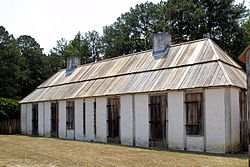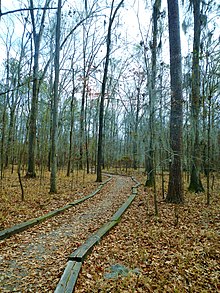Fort Toulouse and Fort Jackson
Fort Toulouse Site-Fort Jackson | |
 A portion of the modern Fort Toulouse reconstruction, taken in 2007. | |
| Nearest city | Wetumpka, Alabama |
|---|---|
| Coordinates | 32°30′12″N 86°15′23″W / 32.50333°N 86.25639°W |
| Built | 1814 |
| NRHP reference No. | 66000148 |
| Significant dates | |
| Added to NRHP | October 15, 1966[1] |
| Designated NHL | October 9, 1960[2] |
Fort Toulouse and Fort Jackson are two forts that shared the same site at the fork of the Coosa River and the Tallapoosa River, near Wetumpka, Alabama.
Fort Toulouse
Fort Toulouse (
The fort was also referred to as the Post of the Alabama, named after the
The number of troops in
Due to the poor living conditions at the fort, which was neglected by the French government, the troops mutinied in 1722. They killed Captain Marchand and captured the other officers, tying them up before leaving the fort. The imprisoned officers managed to escape, and with the help of nearby Creek, they captured the mutineers and sent them to
In 1735, the British built Fort Okfuskee further up the Tallapoosa River at Okfuskee to compete with French trade at Fort Toulouse. Fort Okfuskee was garrisoned by the Province of Georgia from 1735 to 1743 and by the Province of South Carolina from 1744 to 1745.[3] Pierre de Rigaud, marquis de Vaudreuil-Cavagnial, the Governor of French Louisiana, demanded that the commandant of Fort Toulouse notify the Abihka and Tallapoosas that the French would withdraw trade from Fort Toulouse if they did not refuse to help build and destroy any constructed portions of South Carolina's Fort Okfuskee.[4]
By the early 1740s, conditions had improved at the fort. Many soldiers had married French women from Mobile or intermarried with the local Creek. They and other settlers developed numerous farms nearby, which led to improved food supplies. The humid climate caused deterioration of the fort by the late 1740s, and the French planned for a third fort to be built. Under the direction of Captain Francois Saucier, soldiers finished the reconstruction of Fort Toulouse about 1751. It cost nearly half of the military budget for the whole Louisiana colony.
In 1763 the
Fort Jackson
In the midst of the
The site was declared a National Historic Landmark in 1960.[2][6]
During the American Bicentennial in the mid-1970s an attempt was made to reconstruct Fort Toulouse, however the replica was incorrectly built upon the outline of the much larger Fort Jackson.
Fort Toulouse-Fort Jackson State Historic Site

The site was declared a
In the 1980s the park was acquired by the
The Fort Toulouse-Fort Jackson State Historic Site has
The site also features the
The William Bartram Arboretum is an arboretum located at 2521 Fort Toulouse Road, near Wetumpka, Alabama, in the United States. In the 1980s the park became a property of the Alabama Historical Commission and the incorrectly built fort was dismantled and recycled to partially construct a "correct" replica of Ft. Toulouse adjacent to the original site, allowing for a future reconstruction of Ft. Jackson on the actual site once occupied by both forts.
References
- ^ "National Register Information System". National Register of Historic Places. National Park Service. January 23, 2007.
- ^ a b c "Fort Toulouse Site-Fort Jackson". National Historic Landmark summary listing. National Park Service. Archived from the original on 2008-01-11. Retrieved 2007-10-21.
- ^ Wood, Brian M. (1984). "Fort Okfuskee: A British Challenge to Fort Toulouse aux Alibamons". In Waselkov, Gregory A. (ed.). Fort Toulouse Studies. Montgomery, Alabama: Auburn University at Montgomery. p. 41.
- ^ Wood 1984, pp. 47.
- ^ A. J. Langguth, Union 1812, 2006, p. 287
- ^ a b Cecil McKithan (June 29, 1989) National Register of Historic Places Inventory-Nomination: Fort Toulouse / Fort Jackson, National Park Service and Accompanying 1 photo, undated.
- ^ "Mound at Fort Toulouse – Fort Jackson Park". University of Alabama.
Further reading
- Heldman, Donald P. "Fort Toulouse of the Alabamas and the Eighteenth-Century Indian Trade". World Archaeology 5.2 (1973): 163-169.
External links
- Fort Toulouse-Fort Jackson State Historic Site - official site
- [1] Fort Toulouse/Fort Jackson - Alabama Historical Commission
- Fort Toulouse website
- Google books.com (p. 190)




